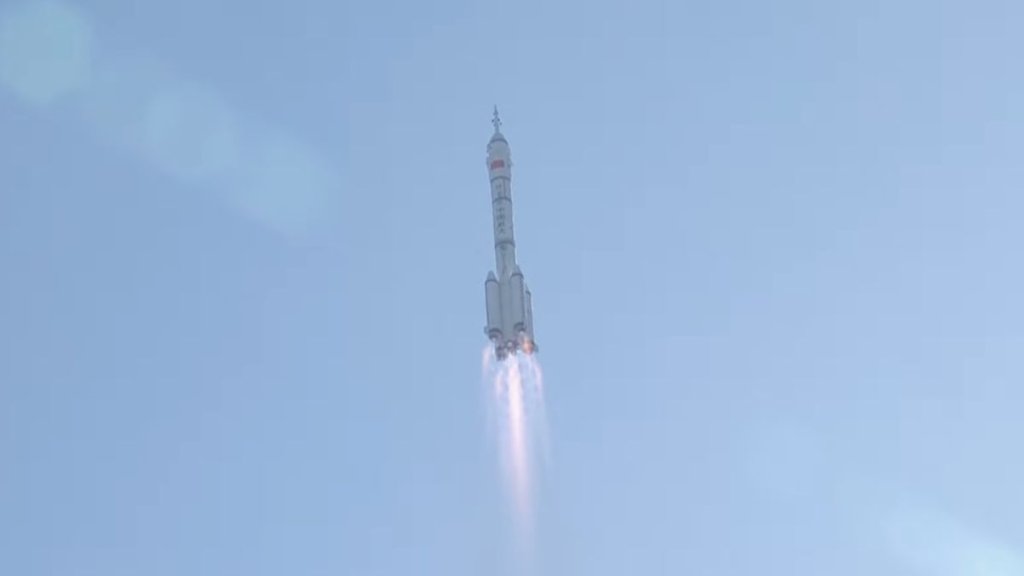China’s youngest crew so far is on its way to the Tiangong space station.
A Long March 2F rocket lifted off from the Jiuquan Satellite Launch Center in the Gobi Desert today (Oct. 25) at 11:14 p.m. EDT (0314 GMT or 11:14 a.m. Beijing Time on Oct. 26), carrying the Shenzhou 17 spacecraft and its three-person crew into orbit.
The spacecraft separated from the launch vehicle as planned 10 minutes into the flight, the China National Space Administration announced, declaring the launch “a complete success.”
Related: Watch Chinese astronauts light a match on Tiangong station (video)
Aboard are mission commander Tang Hongbo, 48, a veteran of Shenzhou 12 — the first crewed mission to the then under-construction Tiangong — and crewmates and former fighter pilots Tang Shengjie, 34, and Jiang Xinlin, 35.
Together, the trio are the youngest crew to visit Tiangong. They are expected to rendezvous and dock with Tiangong around 6.5 hours after launch and begin a six-month-long stay in orbit.
“The space station is another home for us on the journey from Earth to the vast universe,” Tang said at a pre-launch press conference earlier today. “In order to return to space, in the past two years, I have raced against time to complete physical and mental recovery while carrying out studies and training.”
Waiting aboard Tiangong are Shenzhou 16 astronauts Jing Haipeng, Zhu Yangzhu and Gui Haichao. The trio will hand over control of the orbital outpost and prepare for their return to Earth, scheduled for Oct. 31. Jing, Zhu and Gui have been aboard since late May.
The Shenzhou 17 astronauts will conduct science experiments, maintain the space station and carry out science outreach and other activities during their mission.
The crew are also slated to perform the first extravehicular experimental maintenance spacewalk outside of Tiangong. China started constructing the modular space station in April 2021 and, according to officials, it has already taken a few hits.
“Currently, space debris is increasing, so the impacts of small space objects on long-duration operational spacecraft are inevitable,” Lin Xiqiang, deputy director of the CMSA, said during the pre-launch press conference.
“Previous inspection revealed that the space station’s solar panels had also been hit several times by tiny objects in space, suffering minor damage, of course which was taken into account during our design.”
China completed its three-module Tiangong in late 2022. The country aims to keep the orbital outpost permanently occupied for at least a decade.
The station is currently about 20% as massive as the International Space Station, according to Chinese space officials. China’s human spaceflight agency is developing a multipurpose extension module to add to Tiangong, changing it from a “T” shape to that of an “X.” The extension module would then allow further modules to be added to the station.
The Long March 2F that launched the Shenzhou 17 mission had been in a state of near readiness at Jiuquan since the launch of Shenzhou 16, so it could be prepared for liftoff as a lifeboat at short notice in the event of an emergency.
Shenzhou 17 is the sixth crewed mission to Tiangong and China’s 12th astronaut flight overall. Supplies for the mission were delivered aboard the Tianzhou 6 cargo mission in May this year. New supplies will be sent aboard Tianzhou 7 in the first half of 2024.
Yang Liwei became China’s first astronaut in space in 2003 aboard Shenzhou 5, which made the country only the third to achieve independent human spaceflight capabilities after the former Soviet Union, now Russia, and the United States.
India recently conducted a flight abort test as part of a program to launch its astronauts to orbit in 2025.

